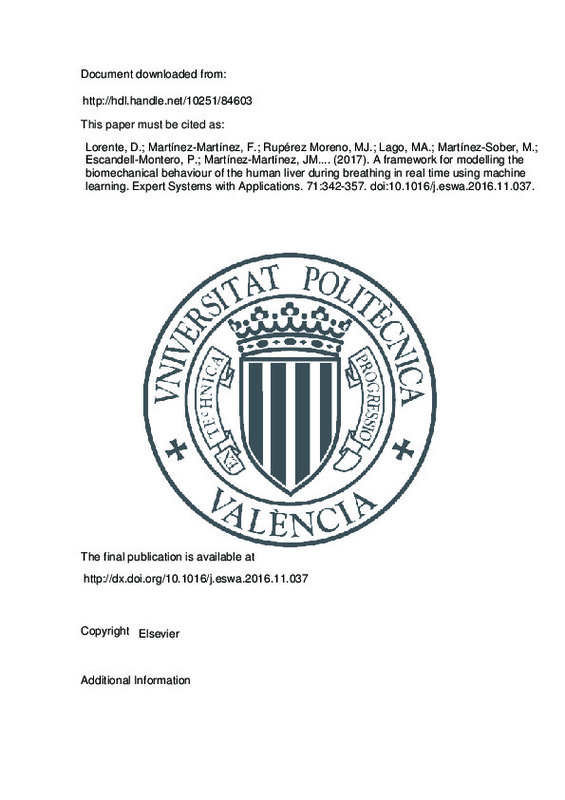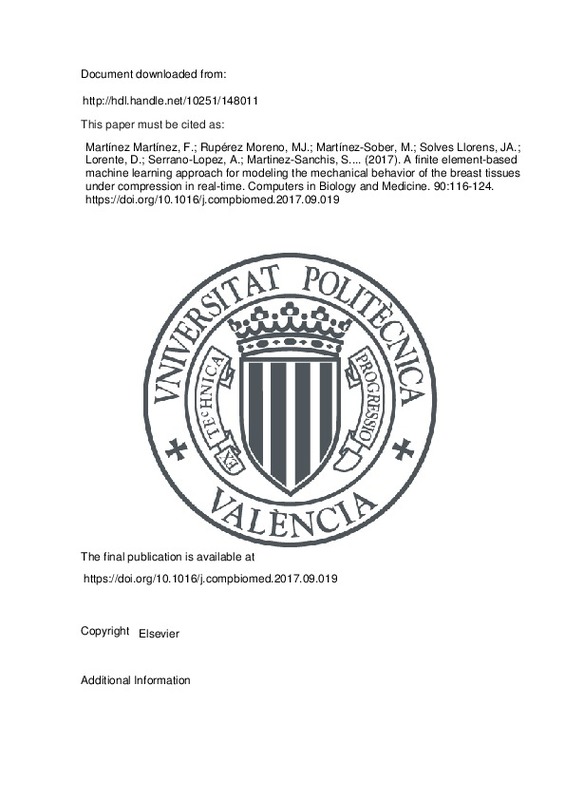JavaScript is disabled for your browser. Some features of this site may not work without it.
Buscar en RiuNet
Listar
Mi cuenta
Estadísticas
Ayuda RiuNet
Admin. UPV
A framework for modelling the biomechanical behaviour of the human liver during breathing in real time using machine learning
Mostrar el registro sencillo del ítem
Ficheros en el ítem
| dc.contributor.author | Lorente, D.
|
es_ES |
| dc.contributor.author | Martínez-Martínez, F.
|
es_ES |
| dc.contributor.author | Rupérez Moreno, María José
|
es_ES |
| dc.contributor.author | Lago, M. A.
|
es_ES |
| dc.contributor.author | Martínez-Sober, M.
|
es_ES |
| dc.contributor.author | Escandell-Montero, P.
|
es_ES |
| dc.contributor.author | Martínez-Martínez, J. M.
|
es_ES |
| dc.contributor.author | Martínez-Sanchis, S.
|
es_ES |
| dc.contributor.author | Serrano-López, A.J.
|
es_ES |
| dc.contributor.author | Monserrat, C.
|
es_ES |
| dc.contributor.author | Martín-Guerrero, J.D.
|
es_ES |
| dc.date.accessioned | 2017-07-06T14:15:44Z | |
| dc.date.available | 2017-07-06T14:15:44Z | |
| dc.date.issued | 2017-04-01 | |
| dc.identifier.issn | 0957-4174 | |
| dc.identifier.uri | http://hdl.handle.net/10251/84603 | |
| dc.description.abstract | Progress in biomechanical modelling of human soft tissue is the basis for the development of new clinical applications capable of improving the diagnosis and treatment of some diseases (e.g. cancer), as well as the surgical planning and guidance of some interventions. The finite element method (FEM) is one of the most popular techniques used to predict the deformation of the human soft tissue due to its high accuracy. However, FEM has an associated high computational cost, which makes it difficult its integration in real-time computer-aided surgery systems. An alternative for simulating the mechanical behaviour of human organs in real time comes from the use of machine learning (ML) techniques, which are much faster than FEM. This paper assesses the feasibility of ML methods for modelling the biomechanical behaviour of the human liver during the breathing process, which is crucial for guiding surgeons during interventions where it is critical to track this deformation (e.g. some specific kind of biopsies) or for the accurate application of radiotherapy dose to liver tumours. For this purpose, different ML regression models were investigated, including three tree-based methods (decision trees, random forests and extremely randomised trees) and other two simpler regression techniques (dummy model and linear regression). In order to build and validate the ML models, a labelled data set was constructed from modelling the deformation of eight ex-vivo human livers using FEM. The best prediction performance was obtained using extremely randomised trees, with a mean error of 0.07 mm and all the samples with an error under 1 mm. The achieved results lay the foundation for the future development of some real-time software capable of simulating the human liver deformation during the breathing process during clinical interventions. | es_ES |
| dc.description.sponsorship | This work has been funded by the Spanish Ministry of Economy and Competitiveness (MINECO) through research projects TIN2014-52033-R and DPI2013-40859-R, both also supported by European FEDER funds. The authors acknowledge the kind collaboration of the personnel from the hospital involved in the research. | en_EN |
| dc.language | Inglés | es_ES |
| dc.publisher | Elsevier | es_ES |
| dc.relation.ispartof | Expert Systems with Applications | es_ES |
| dc.rights | Reserva de todos los derechos | es_ES |
| dc.subject | Soft tissue deformation | es_ES |
| dc.subject | Biomechanical behaviour | es_ES |
| dc.subject | Liver | es_ES |
| dc.subject | Machine learning | es_ES |
| dc.subject | Tree-based regression | es_ES |
| dc.subject.classification | LENGUAJES Y SISTEMAS INFORMATICOS | es_ES |
| dc.subject.classification | INGENIERIA MECANICA | es_ES |
| dc.title | A framework for modelling the biomechanical behaviour of the human liver during breathing in real time using machine learning | es_ES |
| dc.type | Artículo | es_ES |
| dc.identifier.doi | 10.1016/j.eswa.2016.11.037 | |
| dc.relation.projectID | info:eu-repo/grantAgreement/MINECO//DPI2013-40859-R/ES/SISTEMA DE SEGUIMIENTO DE LESIONES TUMORALES HEPATICAS MEDIANTE APROXIMACIONES BIOMECANICAS PARA DIAGNOSIS TEMPRANA Y PLANIFICACION DE TRATAMIENTO./ | es_ES |
| dc.relation.projectID | info:eu-repo/grantAgreement/MINECO//TIN2014-52033-R/ES/SIMULACION DEL COMPORTAMIENTO BIOMECANICO DEL TEJIDO BLANDO EN TIEMPO REAL MEDIANTE INTELIGENCIA COMPUTACIONAL/ | es_ES |
| dc.rights.accessRights | Abierto | es_ES |
| dc.contributor.affiliation | Universitat Politècnica de València. Departamento de Ingeniería Mecánica y de Materiales - Departament d'Enginyeria Mecànica i de Materials | es_ES |
| dc.contributor.affiliation | Universitat Politècnica de València. Departamento de Sistemas Informáticos y Computación - Departament de Sistemes Informàtics i Computació | es_ES |
| dc.description.bibliographicCitation | Lorente, D.; Martínez-Martínez, F.; Rupérez Moreno, MJ.; Lago, MA.; Martínez-Sober, M.; Escandell-Montero, P.; Martínez-Martínez, JM.... (2017). A framework for modelling the biomechanical behaviour of the human liver during breathing in real time using machine learning. Expert Systems with Applications. 71:342-357. doi:10.1016/j.eswa.2016.11.037 | es_ES |
| dc.description.accrualMethod | S | es_ES |
| dc.relation.publisherversion | http://dx.doi.org/10.1016/j.eswa.2016.11.037 | es_ES |
| dc.description.upvformatpinicio | 342 | es_ES |
| dc.description.upvformatpfin | 357 | es_ES |
| dc.type.version | info:eu-repo/semantics/publishedVersion | es_ES |
| dc.description.volume | 71 | es_ES |
| dc.relation.senia | 323612 | es_ES |
| dc.identifier.eissn | 1873-6793 | |
| dc.contributor.funder | Ministerio de Economía y Competitividad | es_ES |
| dc.contributor.funder | European Regional Development Fund | es_ES |







![[Cerrado]](/themes/UPV/images/candado.png)


